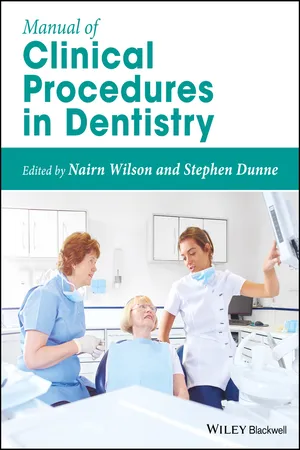
Manual of Clinical Procedures in Dentistry
- English
- ePUB (mobile friendly)
- Available on iOS & Android
Manual of Clinical Procedures in Dentistry
About this book
A definitive manual covering everything you need to know about the core procedures in dentistry
The Manual of Clinical Procedures in Dentistry comprehensively explains the core procedures in dentistry, how to do them, and the rationale that underpins them. Full of useful and easy-to-access information, it acts as a compendium of practical procedures in primary dental care, supporting students and dental practitioners in their daily professional and academic lives.
This manual is a complete, practical guide to the delivery of effective, state of the art oral healthcare—the 'what, when, and how' of clinical practice. It compiles chapters written by expert clinicians on topics such as dental imaging, the management of dental pain, conscious sedation, operative dentistry, implant dentistry, oral medicine and surgery, paediatric dentistry, periodontics, prosthodontics, special care dentistry, dental trauma, aesthetic dentistry, and much more.
- Provides step-by-step guidance on procedures in primary dental care
- Comprehensive coverage of all dental disciplines, from endodontics to orthodontics
- Compiled by two highly experienced editors with contributions from expert authors
- Covers essential non-clinical areas, such as communicating with patients, obtaining valid consent, audit procedures, and handling of complaints
Frequently asked questions
- Essential is ideal for learners and professionals who enjoy exploring a wide range of subjects. Access the Essential Library with 800,000+ trusted titles and best-sellers across business, personal growth, and the humanities. Includes unlimited reading time and Standard Read Aloud voice.
- Complete: Perfect for advanced learners and researchers needing full, unrestricted access. Unlock 1.4M+ books across hundreds of subjects, including academic and specialized titles. The Complete Plan also includes advanced features like Premium Read Aloud and Research Assistant.
Please note we cannot support devices running on iOS 13 and Android 7 or earlier. Learn more about using the app.
Information
1
The Changing Nature of the Practice of Dentistry
Big Picture
Oral and Dental Disease
The Dental Team
- Oral health therapists, which may comprise (dental) therapists with skills and expertise in oral hygiene, or therapists together with dental hygienists.
- Dental nurses, trained together with other members of the dental team, with roles and responsibilities, over and above chairside participation in the provision of treatment, ranging from the recording of simple intraoral radiographic images to the application of preventive measures (e.g. fluoride varnishes) and oral health education. Dental nurses in modern practice environments must have well‐developed skills in running, or at least overseeing, state of the art decontamination and sterilisation procedures.
- Dental technologists, including clinical dental technologists, to work with the chairside team in the provision of indirect restorations, removable prostheses and other appliances. Increasingly, dental technologists are critical to developments in digital dentistry, including, for example, the production of restorations from digital images and CAD CAM (computer assisted design–computer assisted milling). It is anticipated that dental technologists of the future may have as many information technology (IT) skills as traditional manual skills.
- Practice managers with wide‐ranging roles and responsibilities to ensure the safe, efficient running of the practice or dental health centre. Practice managers’ skills and expertise may usefully include, by way of example, business development and marketing, practice accounting, consumables logistics and the management of human resources within the practice or centre.
- Dental receptionists as the patient’s first and most common point of contact with the dental team. In this role, receptionists require excellent human relationship and communication skills, together with skills in diary management, aimed at the best use of the time and skills of the various members of the dental team. Dental receptionists, in addition to requiring good telephone and face to face communication skills, are extending their roles to include multimedia communications with patients. Receptionists may also pay crucial roles in patient satisfaction surveys and the initial response to concerns and complaints.
The Practice Environment
Regulation
- Proportionate: Regulatory intervention only when necessary, with measured, cost‐effective remedies appropriate to the risk posed.
- Consistent: Interrelated rules and standards implemented fairly.
- Targeted: Focused arrangements fit for purpose.
- Transparent: Open, simple, user‐friendly regulation.
- Accountable: Subject to, and satisfying public scrutiny.
- Agility: Forward‐looking and evolving to meet changing needs.
- Patient respect and autonomy.
- Do no harm (non‐maleficence).
- Act in the best interest of the patient – ‘do good’ (beneficence).
- Honesty and truthfulness (veracity).
Table of contents
- Cover
- Title Page
- Table of Contents
- Preface
- List of Contributors
- 1 The Changing Nature of the Practice of Dentistry
- 2 An Overview of Patterns and Trends in Oral and Dental Diseases
- 3 Requirements in the Clinical Environment
- 4 Communicating With Patients
- 5 Obtaining Valid Consent
- 6 Procedures in the Assessment and Examination of Patients
- 7 Procedures and Arrangements for the Prevention of Oral and Dental Diseases
- 8 Procedures in Dental Imaging
- 9 Procedures in the Management of Dental Pain
- 10 Procedures in Conscious Sedation
- 11 Procedures in Operative Dentistry
- 12 Procedures in Endodontics
- 13 Procedures in Implant Dentistry
- 14 Procedures in Oral Medicine
- 15 Procedures in Oral Surgery
- 16 Procedures in Orthodontics
- 17 Procedures in Paediatric Dentistry
- 18 Procedures in Periodontics
- 19 Procedures in Prosthodontics
- 20 Procedures in Special Care Dentistry
- 21 Procedures in the Management of Acute Dental Trauma
- 22 Procedures in Aesthetic Dentistry
- 23 Medical Emergencies
- 24 Audit in Dental Practice
- 25 Procedures for the Management of Patient Concerns and Complaints
- Index
- End User License Agreement